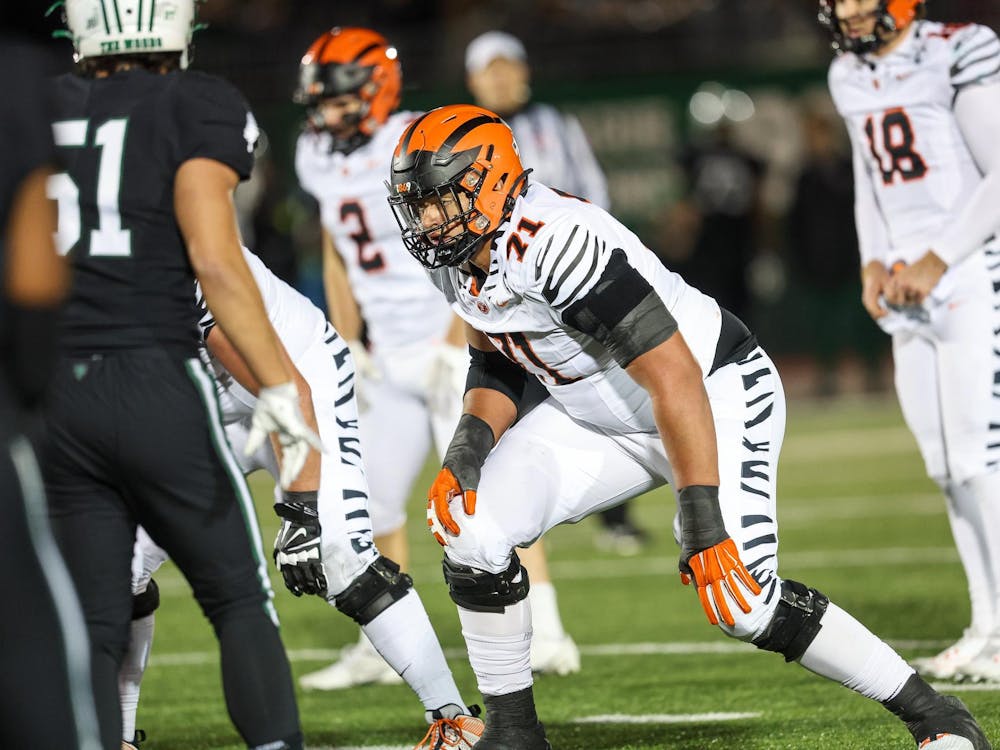You know what happened next: The Tigers drove 90 yards to complete a miraculous comeback and win 39-34. But they might never have had that chance had Harvard gone through with that fourth-down play; a successful conversion would have allowed the visitors to run out the clock. Should they have taken that gamble?
Harvard head coach Tim Murphy was asked after the game if he considered going for it. “I did, briefly, but the bottom line is, I believe in our defense,” he said. “From that standpoint, especially since they only needed a field goal, it’s not the right play.”
Murphy’s reasoning raises a few questions. If he has that much faith in his defense, shouldn’t he trust it to stop Princeton with a shorter field if a fourth-down conversion failed? To get into field-goal range, the Tigers would have had to drive about 25 yards, which they never did against Harvard’s defense in the first half. Moreover, if Murphy believed in his defense — which had allowed quick touchdowns on the previous three drives — shouldn’t he have trusted his offense, which is the third-most productive unit in the Football Championship Subdivision and torched Princeton for 634 yards, to gain one more measly yard and ice the game?
Instead of talking in abstract terms of trust and faith, let’s use a more concrete framework involving probability. If Harvard goes for it on fourth-and-1, there are two possible outcomes: The Crimson converts, in which case its chances of winning are roughly 100 percent, or it fails, in which case it wins only if it can prevent the Tigers from scoring from midfield.
How likely is it that Harvard would gain one yard? The NFL average for fourth-and-one conversions is 72 percent, according to a study done by the league in 2008; coincidentally, Harvard had gained at least one yard in 73 percent of its plays on Saturday. Princeton has a strong defensive line, but the Crimson has one of the nation’s best offenses and a versatile quarterback. Given that Harvard could pick its best short-yardage play, and to make the math simple, let’s say it had a 75 percent chance of converting.
How likely is it that Princeton would score from midfield, if Harvard did not convert? That’s a trickier question. The Tigers only needed a field goal to win, but that was still no guarantee — to get in range, they would have needed about 25 yards, which they have gained on 42 percent of their drives this year. In an end-game situation, Princeton would have the advantage of using all four downs instead of worrying about punting, but it also had the time constraint, as well as the fact that a field goal attempt might fail — freshman Nolan Bieck hasn’t made a kick longer than 34 yards this season. Let’s say Princeton’s chances of winning in that situation would be 40 percent.
Finally, how likely is it that Princeton would score after a punt? The Tigers could expect to start around their 10- or 20-yard line after the kick, though there was a chance that Princeton would block it, as it did Harvard’s previous punt attempt. The Tigers have scored on 23 percent of their drives starting inside their own 25-yard line this year, but many of those drives took longer than two minutes. This is the hardest number to estimate, but factoring in the chance of a blocked or shanked punt, let’s say Princeton’s odds of receiving a punt and scoring were 18 percent.
Putting it all together: If Harvard goes for it, its chance of winning is the probability it converts, plus the probability it does not convert and stops Princeton from midfield: 75 percent + 15 percent = 90 percent. If Harvard punts, its chance of winning is the probability it stops Princeton after a punt: 82 percent. So, given the three assumptions above, Murphy should have called a fourth-down play — and his failure to do so hurt Harvard’s chances of winning.
The point isn’t really that Murphy made a bad call. If you have a different estimate of Harvard’s fourth-down rate or Princeton’s odds of scoring from different points on the field, your calculations might be different, though I’ve found it hard to come up with a plausible scenario in which punting would clearly be the better option. The point is that such critical decisions — when one choice could swing a game and possibly the Ivy League championship by eight percentage points or more — should be made with this win-maximizing framework in mind. I’m not saying coaches should carry calculators onto the sideline (wouldn’t that be awesome?), but they should consider all aspects of the decision instead of blindly trusting their defense when a perfectly good offense is already on the field.
Coincidentally, almost this same situation took place in the NFL last month. The Carolina Panthers had the ball and a one-point lead, facing fourth-and-1 from the Atlanta Falcons’ 44-yard line with 1:44 to play on Sept. 30. According to ESPN Stats & Info, choosing to punt instead of going for it would reduce the Panthers’ odds of winning by 26 percentage points.
Naturally, Carolina still punted, and the Falcons drove down the field to win.








